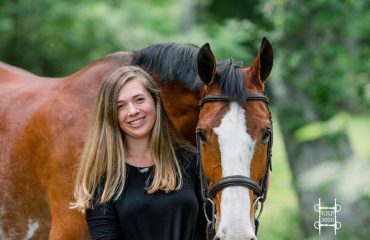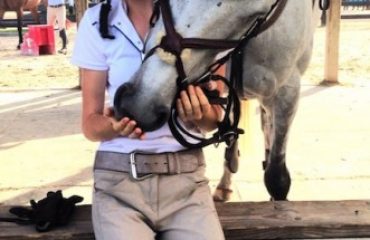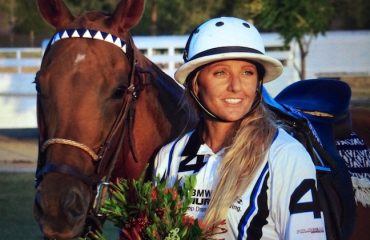
Boyd, in Japan, with the riders from his clinic.
Boyd was honored and privileged to go to Japan in November, for the third year in a row, to teach a series of retired racehorse retraining clinics. The idea originally formulated thanks to his 2016 Olympic partner Blackfoot Mystery, an American Thoroughbred who was adopted off the track and eventually ended up in his hands. The clinics are sponsored by Godolphin, Darley, the Japanese Racing Association and the National Riding Club Association of Japan. Boyd shared his experience with Sidelines.
As a country, Japan is bursting with enthusiasm for equestrian sports at the moment; the Olympics are coming to Tokyo this year and Japan has some of the best horses and riders in the world in eventing right now. Japan is all abuzz with horse sports. They have an awesomely run and organized Thoroughbred racing system; they only race on weekends, and breed just enough horses to fill these races. They’re longer-distance races and as such they breed bigger, stronger animals that are very well suited to becoming sport horses in their second careers.
This year we did several single day clinic/demonstrations. We spent the first half of each day in a big lecture room where I told 60 or 70 people about my experiences retraining Thoroughbreds and the advantages of rehoming a Thoroughbred retired from racing. In these one-day clinics, we have three horses at different stages of their careers. I usually ride and comment to the spectators, but this year I’m injured so I was lucky enough to get a few top Japanese riders to ride while I commented.
The first horse was a very green horse that had just finished racing and never jumped before. The horses at this clinic were 4 years old and lovely, big types. We did flatwork first just trying to get them to change the shape of their body, becoming more supple, and trying to lower the horse’s neck and gently start teaching it to go in a slightly rounder shape.
After this I showed them how I might introduce a horse to jumping. We started with walking and trotting over a single pole, then built up to three trot poles in succession and finally cantered a small cavaletti on a circle. Next, we had a small crossrail with a placing pole and started trotting the pole to the jump, landing and departing in canter. I told them I like to trot to fences because it’s hard for horses to rush in trot; they have to use strength, not momentum, and I think it gives them a good understanding of what to do with their bodies.
Next was a horse slightly farther along. We did similar exercises, but introduced some lateral work: leg yield and shoulder-in, and then lengthening and shortening of the canter. When it came to the jumping, I showed them some of the gymnastics and gridwork I’ve been doing. I came up with a couple of exercises for improving the horses’ shape; we started at trot and moved up to canter and used some lead/guiding poles to correct the horse in the approach without too much interference from the rider.

Boyd, in Japan, with the riders from his clinic.
The third horse was a 7-year-old that had a couple of years of training since it finished racing. We built a pretty simple course and really tried to formulate this session around the horse’s first competition. We had a simple vertical setup and I showed everyone the warm-up routine I thought would suit a young Thoroughbred: nice verticals and slightly rampy, ascending oxers. We built a pretty easy course of about nine jumps, including a forgiving combination, and practiced going around the course once at a small height, then raised it to a slightly more challenging height once he had been around it.
Obviously, it’s hard to communicate to a group of people everything you’ve learned over 20 years of training in a one-day session, so I really tried to simplify everything and put together a package of what has worked for me over the years. I will say they have an awesome group of horses available that have finished racing in Japan. There were many horses that I was drooling over: big, tall, rangy Thoroughbreds with good dispositions and the championship look of a performance horse.
I’m very grateful to have a Japanese-born jockey who rides jump races in Australia, who translates for me. He’s with me from the moment we have breakfast until we finish dinner since it’s so important to get the message across to the non-English-speaking spectators. I can’t tell you what a great experience it is working with the Japanese people in general: They’re eager for knowledge, and the treatment I get thanks to Godolphin is first-class. It’s easy teaching when people are very engaged. Of course, I’m hoping my next trip to Japan will be on the 2020 Olympic Eventing Team, but I’m also looking forward to returning for next year’s clinic.
Photo courtesy of Courtesy Godolphin













